“My sufferings I can compare to nothing else than the burning agonies of hell!” – Solomon Northup, Twelve Years a Slave.
Black History Month is observed in October in the United Kingdom, and throughout February in the United States of America. The civil rights struggle is alive throughout the world, and recent events have fuelled the conversation about our shared history and the uncomfortable truth that for centuries our nations have thrived due to the suffering of others.
Growing up in the UK, I’ve never been taught about the American Civil War, or really much history about the nineteenth century outside of the Industrial Revolution. So, when researching into the background of these photos, I learnt a considerable amount about how much the trade in human beings built the modern world.
The slave trade throughout the British Empire was abolished in 1807, however, Britain continued to depend on slave labour in the plantations of the USA for major consumer goods, such as coffee, cotton, rum, sugar, and tobacco.
The technology did not exist to capture the British slave trade on film, but the final years of slavery in the USA were recorded. Therefore the photos in this article were all taken in America, from the 1850s to the 1930s and they show the horrors of life for those living under slavery and the accounts of those who survived into old age as free as they were allowed to live under a still highly segregated society.
I have colourised these photos as a means to share some of the stories of those pictured. From past experience, I know how often a black and white photo is ignored in a news feed, and how much more engaging a colour version can be for many readers. I believe that colourising a photo opens a window into another time, and with the world the way it is, it’s important to revisit the stories of these people in order to better understand the world today.
The American Civil War was also the first conflict in which photography played an important role, with the new technology able to give us incredible records of not only the military operations, but also photographs of escaped slaves fleeing the south for refuge in the northern states. These photos were used by the Union as the first wartime photographic propaganda, ultimately paving the way for the abolition of slavery.
If you would like to see more of my colourised photos please visit my website or follow me on social media. Check out more of my posts on Bored Panda here, here, here, here, and here.
All colourised images © Tom Marshall (PhotograFix) 2020.
More info: photogra-fix.com | Facebook | Instagram | twitter.com
The Scourged Back

This photo ‘The Scourged Back’ is one of the most well-known photographs from this period and was widely circulated by slavery abolitionists. It is one of the earliest examples of photography used as propaganda. The escaped slave’s name is Gordon, also known as ‘Whipped Peter’, showing his scarred back at a medical examination, Baton Rouge, Louisiana on 2nd April 1863.
Gordon escaped his master in Mississippi by rubbing himself with onions to throw off the bloodhounds. He took refuge with the Union Army at Baton Rouge, and in 1863, three engraved portraits of him were printed in Harper’s Weekly, showing the man ‘as he underwent the surgical examination previous to being mustered into the service — his back furrowed and scarred with the traces of a whipping administered on Christmas Day last.’
A contemporary newspaper, The New York Independent, commented: “This Card Photograph should be multiplied by the 100,000 and scattered over the states. It tells the story in a way that even Mrs. Stowe cannot approach, because it tells the story to the eye.” Mrs. Stowe was a reference to Harriet Beecher Stowe, author of the anti-slavery novel ‘Uncle Tom’s Cabin’.
Escaped Slaves
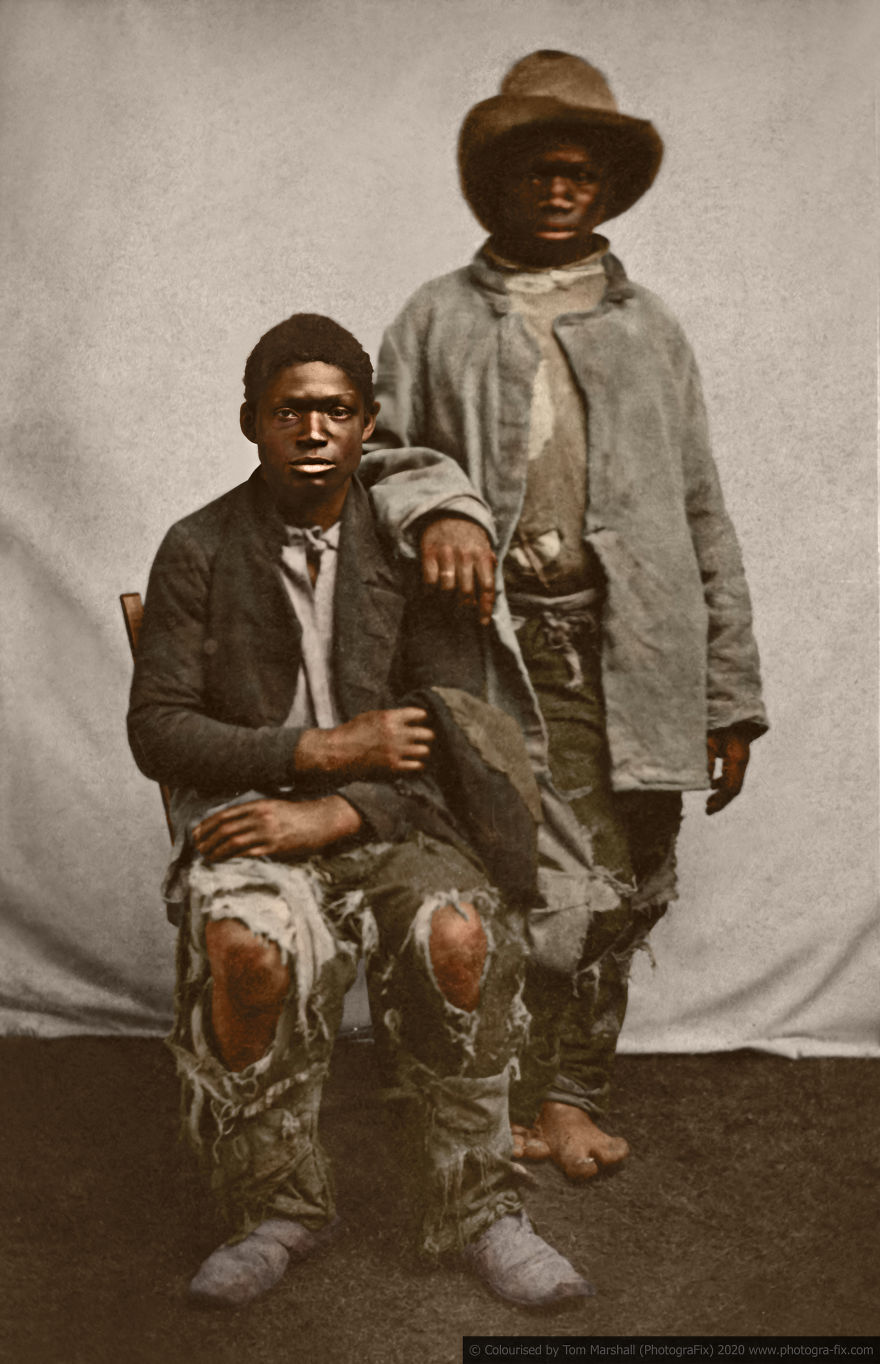
Two unidentified escaped slaves wearing ragged clothes, photographed by McPherson & Oliver, Baton Rouge, Louisiana. This photo was taken sometime during the Civil War of 1861-1865, though the exact date is unknown, and the caption on the reverse of the image reads ‘Contrabands just arrived’. Contraband was a term commonly used to describe a new status for certain escaped slaves or those who affiliated with Union forces.
In August 1861, the Union Army determined that the USA would no longer return escaped slaves who went to Union lines and classified them as ‘contraband of war’, or captured enemy property. They used many as labourers to support Union efforts and soon began to pay them wages. The former slaves set up camps near Union forces, and the Army helped support and educate both adults and children among the refugees.
Thousands of men from these camps enlisted in the United States Colored Troops when recruitment started in 1863. At war’s end, more than 100 contraband camps existed in the South, including the Freedmen’s Colony of Roanoke Island, where 3500 former slaves worked to develop a self-sufficient community.
Willis Winn, aged 116
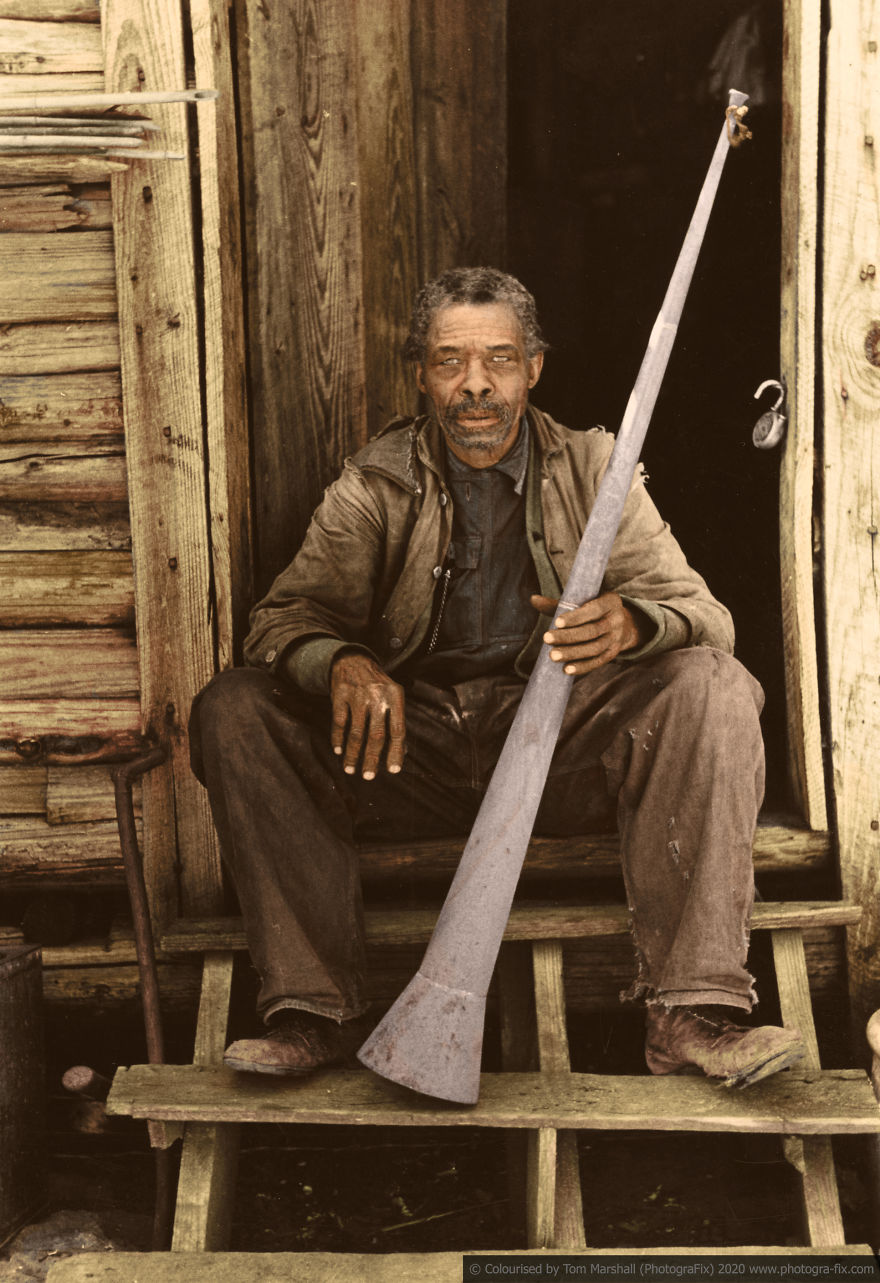
This photo of Willis Winn was also taken by Russell Lee as part of the Federal Writers Project in April 1939, in Marshall, Texas. He is holding the horn used to call slaves to work every day, and claimed to be 116 years old when the photo was taken. He was born in Louisiana, a slave of Bob Winn, who Willis said taught him from his youth that his birthday was March 10, 1822.
When interviewed by Lee, Willis was living alone in a one-room log house in the rear of the Howard Vestal home on the Powder Mill Road, north of Marshall, and was supported by an $11.00 per month old-age pension. He recalled; “Massa Bob’s house faced the quarters where he could hear us holler when he blowed the big horn for us to git up. All the houses were made of logs and we slept on shuck and grass mattresses what was allus full of chinches. I still sleep on a grass mattress, ’cause I can’t rest on cotton and feather beds.”
Willis’ interview in 1939 showed how little things had changed for many people in the United States decades on from the abolition of slavery.
“They is plenty niggers in Louisiana that is still slaves. A spell back I made a trip to where I was raised, to see my old missy ‘fore she died, and there was niggers in twelve or fourteen miles of that place that they didn’t know they is free. They is plenty niggers round here what is same as slaves, and has worked for white folks twenty and twenty-five years and ain’t drawed a five cent piece, jus’ old clothes and somethin’ to eat. That’s the way we was in slavery.”
Omar ibn Said ‘Uncle Marian’
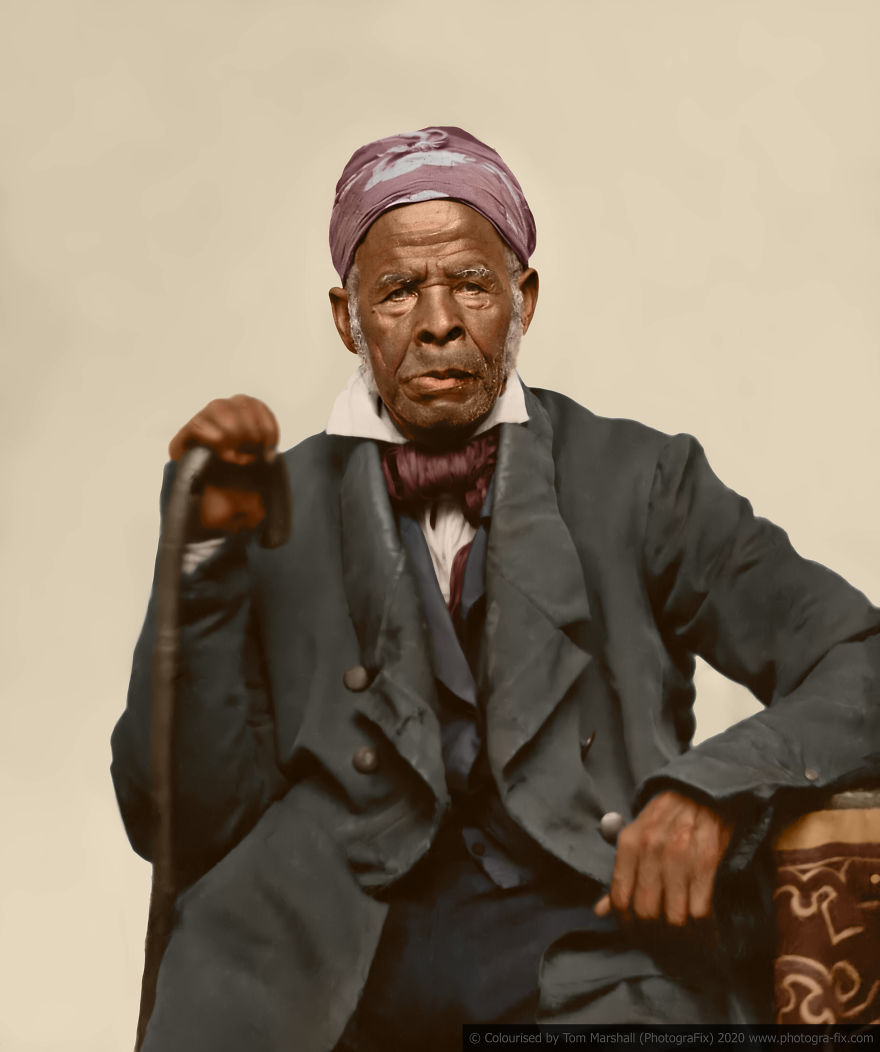
Omar ibn Said was born in 1770, in what is now Senegal in West Africa. He was a well-educated man who received a formal Islamic education and spent 25 years of his life studying with prominent Muslim scholars in Africa, learning subjects ranging from arithmetic to theology. In 1807, Said was enslaved and transported to South Carolina in the United States, where he remained as a slave until his death aged 94 in 1864. He was also known as Uncle Moreau, Uncle Marian, and Prince Omeroh.
When Said first arrived in South Carolina, he was purchased by a young upcountry planter who treated him harshly. Said described him as a “small, weak and wicked man, who feared not God at all”, and he ran away to North Carolina, where he was arrested and put into jail as a runaway slave.
Whilst in jail, Omar ibn Said attracted attention by writing on the walls in Arabic, and was purchased from the SC planter by Jim Owen, a resident of Bladen County, North Carolina. In his autobiography, Said described Owen as being a good man. “I continue in the hand of Jim Owen who never beats me, not scolds me. I neither go hungry not naked, and I have no hard work to do. I am not able to do hard work for I am a small man and feeble. During the last twenty years I have known no want in the hand of Jim Owen”. This photo of Said was taken c1850 and is captioned ‘Uncle Marian, a slave of great notoriety, of North Carolina’.
Potato Picking on Hopkinson’s Plantation

This photo shows sweet potato planting on James Hopkinson’s Plantation, Edisto Island, South Carolina. It was taken on 8th April 1862 by Henry P Moore, a native of New Hampshire who travelled to South Carolina to document the Civil War. Early in the war Union gunboats bombarded the Sea Islands off the coast of South Carolina and Confederate planters left hastily, ordering their field hands and house servants to accompany them. Most ignored their former masters and remained.
The Union government eventually appointed northern antislavery reformers to manage the lands abandoned by the planters and to oversee the labour of ex-slaves. These reformers wanted to demonstrate the superiority of free labour over slave labour in the cultivation of cotton. Most freed people, however, did not want to grow cotton or produce for the market, preferring instead to grow corn, potatoes, and other subsistence crops.
Auction & Negro Sales, Whitehall Street, Atlanta, Georgia, 1864
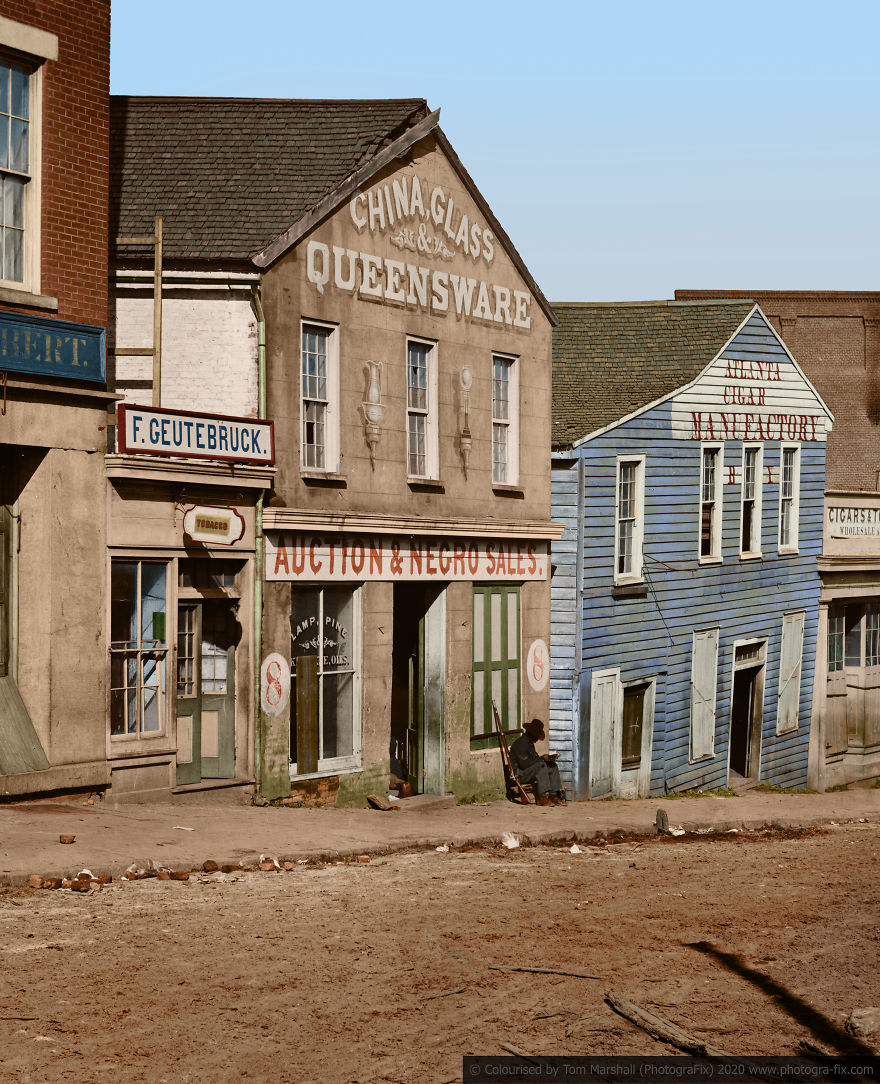
This photograph is a view of Auction & Negro Sales, Whitehall Street, Atlanta, Georgia, 1864. It was captured by George N. Barnard, the official photographer of the Chief Engineer’s Office, during the Union occupation of Georgia. When in use, the auction house would have seen enslaved Africans inspected for sale, poked, prodded, and forced to open their mouths for the buyers.
The auctioneer would decide a price to start the bidding. It would be higher for young enslaved people and lower for older, very young or sickly enslaved people. Buyers would bid against each other, and sold to the person who bid the most money.
Unnamed slave of Richard Townsend
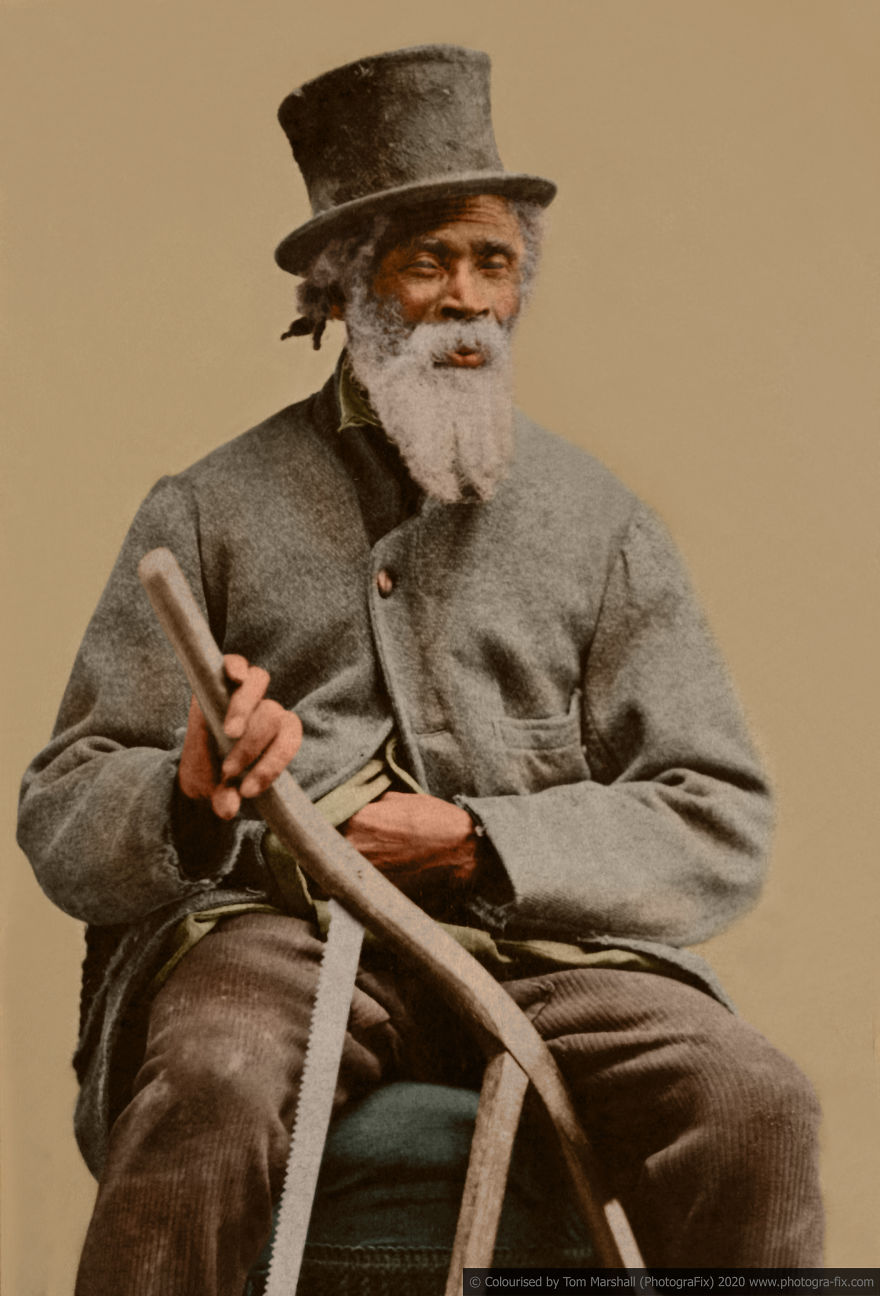
Pictured is an unnamed slave of Richard Townsend. The photo was taken at W.H. Ingram’s Photograph and Ferrotype Gallery, No. 11 West Gay Street, West Chester, Pennsylvania.
Former slave Georgia Flournoy
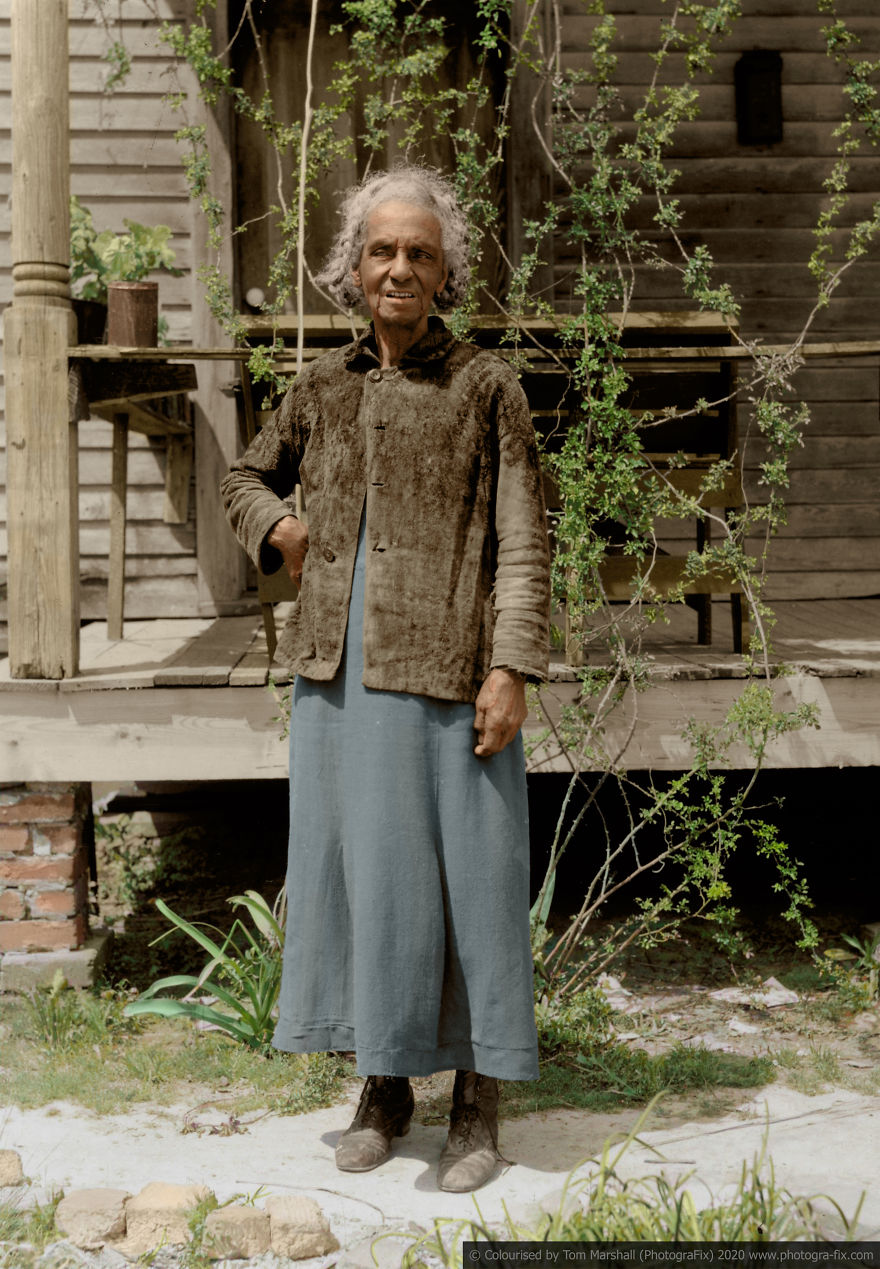
Former slave Georgia Flournoy is photographed outside her home, in Eufaula, Alabama on 27th April 1937. Georgia was interviewed by the Federal Writers project and she stated she was over 90 years old.
She was born in Elmoreland, a plantation in Old Glenville, 17 miles north of Eufaula, and said that she never knew her mother as she died during childbirth. Georgia worked in the ‘Big House’, as a nursemaid, and was not allowed to socialise with any of the other enslaved people on the plantation.
Demonstration of a Bell Rack
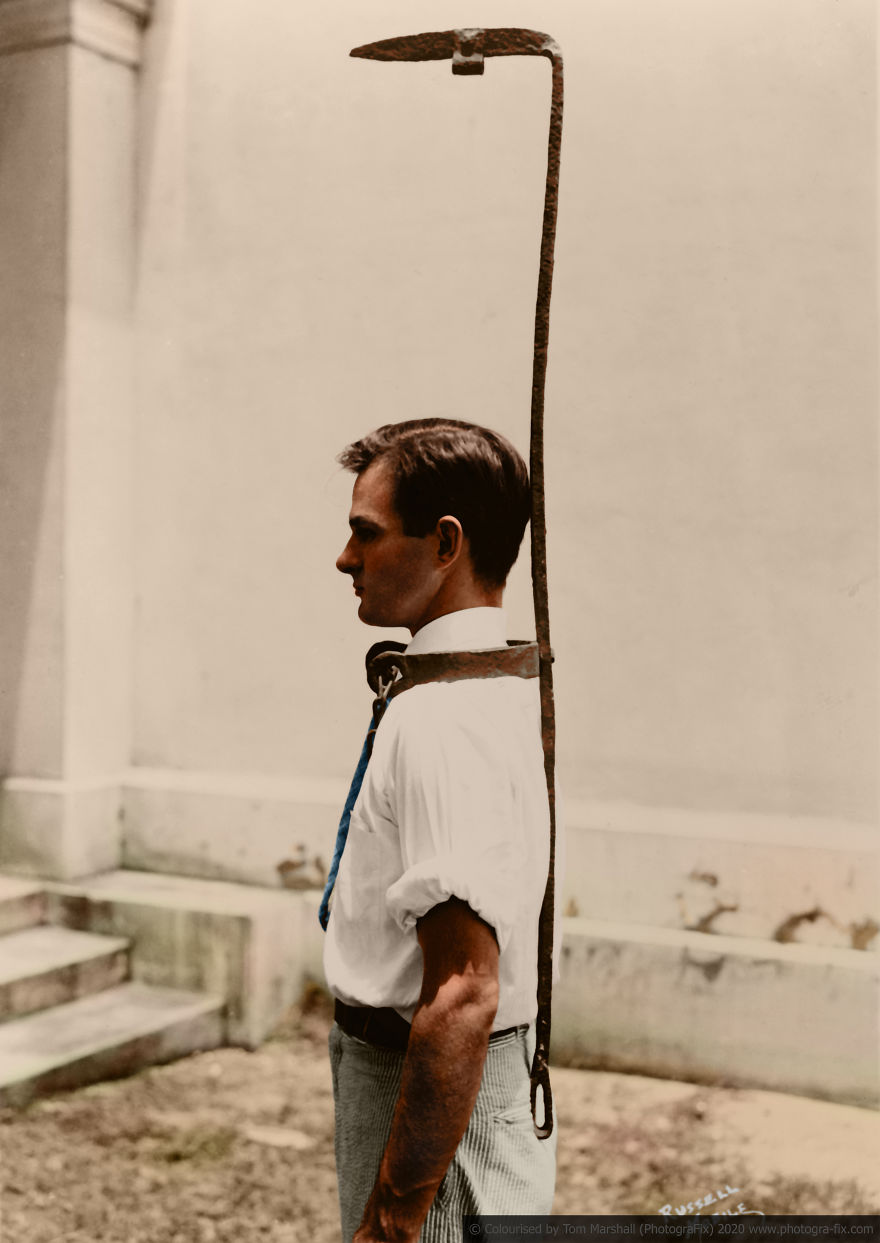
Russell Lee also captured this image of Richbourg Gailliard, assistant to the director of the Federal Museum, Mobile Alabama, demonstrating a ‘Bell Rack’. This was a contraption used by an Alabama slave owner to guard a runaway slave.
The rack was originally topped by a bell which rang when the runaway attempted to leave the road and go through foliage or trees. It was attached around the neck as shown in the picture. A belt passed through the loop at the bottom to hold the iron rod firmly fastened to the waist of the wearer.
‘Old Aunt’ Julia Ann Jackson
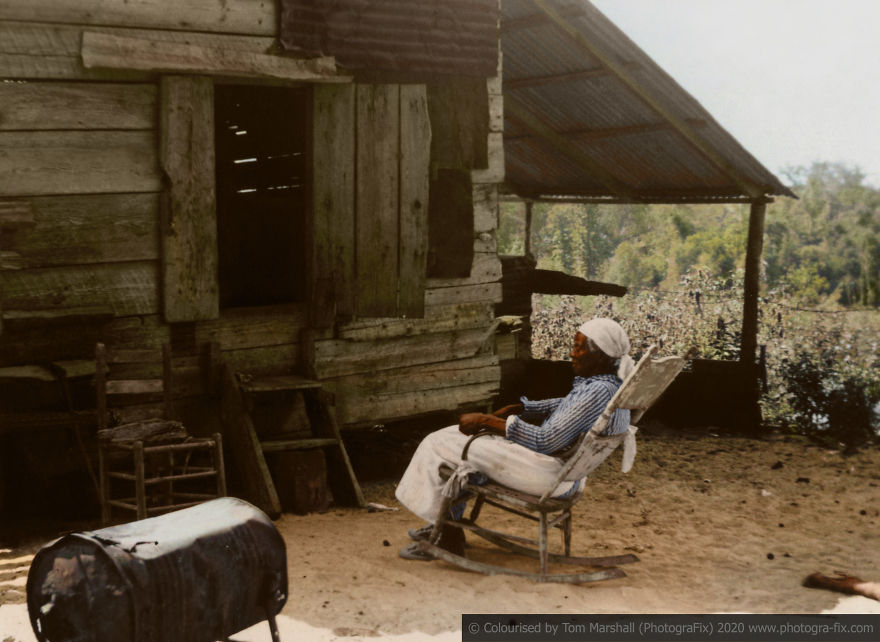
Former slave ‘Old Aunt’ Julia Ann Jackson, aged 102 and the corn crib where she lived. This photo was taken in 1938, in El Dorado, Arkansas. She used the large battered tin can for a cooking stove.
from Bored Panda https://ift.tt/3j8YvME







0 Yorumlar